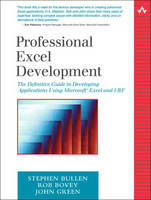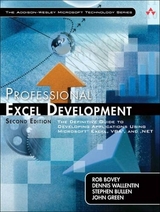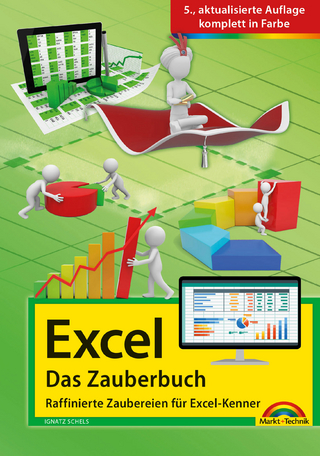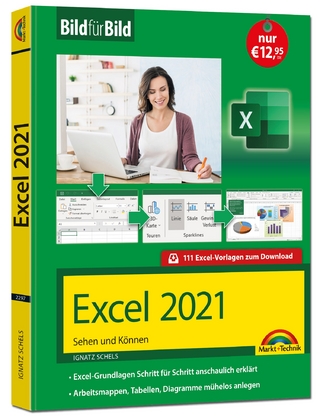
Professional Excel Development
Addison-Wesley Educational Publishers Inc (Verlag)
978-0-321-26250-9 (ISBN)
- Titel erscheint in neuer Auflage
- Artikel merken
Microsoft Excel can be much more than just a spreadsheet. It has become adevelopment platform in it own right. Applications written using Excel are partof many corporations' core suites of business-critical applications. In spite ofthis, Excel is too often thought of as a hobbyist's platform. While there arenumerous titles on Excel and VBA, until now there have been none thatprovide an overall explanation of how to develop professional-quality Excel-basedapplications. All three authors are professional Excel developers who runtheir own companies developing Excel-based apps for clients ranging fromindividuals to the largest multinational corporations. In this book they showhow anyone from power users to professional developers can increase thespeed and usefulness of their Excel-based apps.
Stephen Bullen is founder of Office Automation Ltd., a specialist in Excel, Access and Visual Basic development that serves many of the world's largest businesses. Rob Bovey is president of Application Professionals, a software developer specializing in Microsoft Office, Visual Basic and SQL Server applications. He has developed several add-ins shipped by Microsoft with Excel. John Green is founder of Execuplan Consulting, a specialist in Excel and Access business application development. The authors have each held Microsoft's coveted Excel MVP status for eight consecutive years, and are coauthors of Excel 2000/Excel 2002 VBA Programmer's Reference (Wrox Press). © Copyright Pearson Education. All rights reserved.
Contents
Acknowledgments.
About the Authors.
1. Introduction.
About This Book
The Excel Developer
Excel as an Application Development Platform
Structure
Examples
Supported Versions
Typefaces
On the CD
Help and Support
Feedback
2. Application Architectures.
Concepts
Conclusion
3. Excel and VBA Development Best Practices.
Naming Conventions
Best Practices for Application Structure and Organization
General Application Development Best Practices
Conclusion
4. Worksheet Design.
Principles of Good Worksheet UI Design
Program Rows and Columns: The Fundamental UI Design Technique
Defined Names
Styles
User Interface Drawing Techniques
Data Validation
Conditional Formatting
Using Controls on Worksheets
Practical Example
Conclusion
5. Function, General and Application-Specific Add-ins.
The Four Stages of an Application
Function Library Add-ins
General Add-ins
Application-Specific Add-ins
Practical Example
Conclusion
6. Dictator Applications.
Structure of a Dictator Application
Practical Example
Conclusion
7. Using Class Modules to Create Objects.
Creating Objects
Creating a Collection
Trapping Events
Raising Events
Practical Example
Conclusion
8. Advanced Command Bar Handling.
Command Bar Design
Table-Driven Command Bars
Putting It All Together
Loading Custom Icons from Files
Hooking Command Bar Control Events
Practical Example
Conclusion
9. Understanding and Using Windows API Calls.
Overview
Working with the Screen
Working with Windows
Working with the Keyboard
Working with the File System and Network
Practical Examples
Conclusion
10. Userform Design and Best Practices.
Principles
Control Fundamentals
Visual Effects
Userform Positioning and Sizing
Wizards
Dynamic Userforms
Modeless Userforms
Control Specifics
Practical Examples
Conclusion
11. Interfaces.
What Is an Interface?
Code Reuse
Defining a Custom Interface
Implementing a Custom Interface
Using a Custom Interface
Polymorphic Classes
Improving Robustness
Simplifying Development
A Plug-in Architecture
Practical Example
Conclusion
12. VBA Error Handling.
Error-Handling Concepts
The Single Exit Point Principle
Simple Error Handling
Complex Project Error Handler Organization
The Central Error Handler
Error Handling in Classes and Userforms
Putting It All Together
Practical Example
Conclusion
13. Programming with Databases.
An Introduction to Databases
Designing the Data Access Tier
Data Access with SQL and ADO
Further Reading
Practical Example
Conclusion
14. Data Manipulation Techniques.
Excel’s Data Structures
Data Processing Features
Advanced Functions
Conclusion
15. Advanced Charting Techniques.
Fundamental Techniques
VBA Techniques
Conclusion
16. VBA Debugging.
Basic VBA Debugging Techniques
The Immediate Window (Ctrl+G)
The Call Stack (Ctrl+L)
The Watch Window
The Locals Window
The Object Browser (F2)
Creating and Running a Test Harness
Using Assertions
Debugging Shortcut Keys that Every Developer Should Know
Conclusion
17. Optimizing VBA Performance.
Measuring Performance
The PerfMon Utility
Creative Thinking
Macro-Optimization
Micro-Optimization
Conclusion
18. Controlling Other Office Applications.
Fundamentals
The Primary Office Application Object Models
Practical Example
Conclusion
19. XLLs and the C API.
Why Create an XLL-Based Worksheet Function
Creating an XLL Project in Visual Studio
The Structure of an XLL
The XLOPER and OPER Data Types
The Excel4 Function
Commonly Used C API Functions
XLOPERs and Memory Management
Registering and Unregistering Custom Worksheet Functions
Sample Application Function
Debugging the Worksheet Functions
Miscellaneous Topics
Additional Resources
Conclusion
20. Combining Excel and Visual Basic 6.
A Hello World ActiveX DLL
Why Use VB6 ActiveX DLLs in Excel VBA Projects
In-Process versus Out-of-Process
Automating Excel From a VB6 EXE
Practical Examples
Conclusion
21. Writing Add-ins with Visual Basic 6.
A Hello World Add-in
The Add-in Designer
Installation Considerations
The AddinInstance Events
Command Bar Handling
Why Use a COM Add-in?
Automation Add-ins
Practical Example
Conclusion
22. Using VB.NET and the Visual Studio Tools for Office.
Overview
How to Leverage the .NET Framework
Managed Workbooks
Managed Excel Add-ins
Hybrid VBA/VSTO Solutions
The VSTO Security Model
The Big Issues
Further Reading
Practical Example
Conclusion
23. Excel, XML and Web Services.
XML
Web Services
Practical Example
Conclusion
24. Providing Help, Securing, Packaging and Distributing.
Providing Help
Securing
Packaging
Distributing
Conclusion
Index.
| Erscheint lt. Verlag | 1.2.2005 |
|---|---|
| Verlagsort | New Jersey |
| Sprache | englisch |
| Maße | 178 x 231 mm |
| Gewicht | 1361 g |
| Themenwelt | Informatik ► Office Programme ► Excel |
| Mathematik / Informatik ► Informatik ► Software Entwicklung | |
| ISBN-10 | 0-321-26250-6 / 0321262506 |
| ISBN-13 | 978-0-321-26250-9 / 9780321262509 |
| Zustand | Neuware |
| Informationen gemäß Produktsicherheitsverordnung (GPSR) | |
| Haben Sie eine Frage zum Produkt? |
aus dem Bereich



